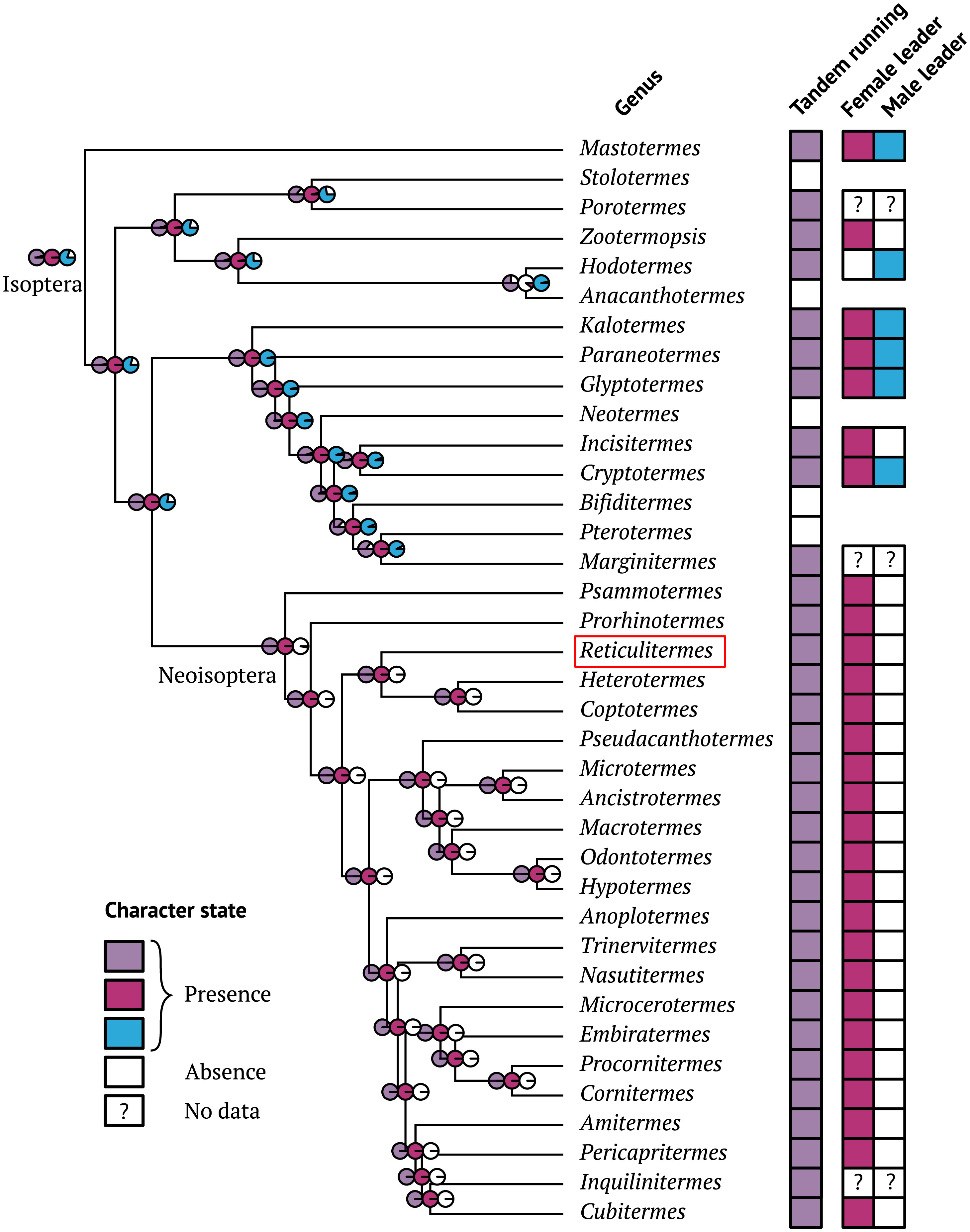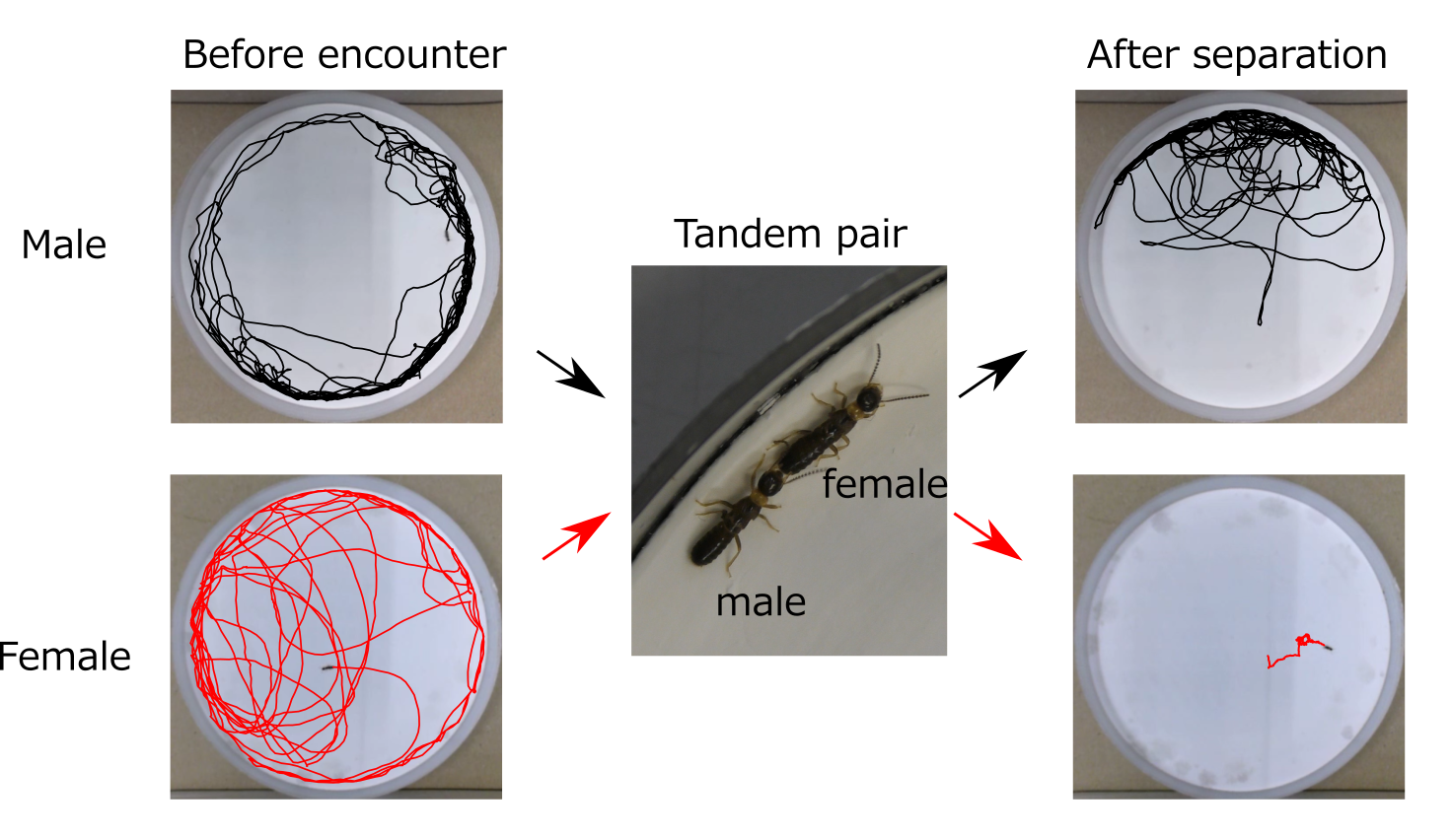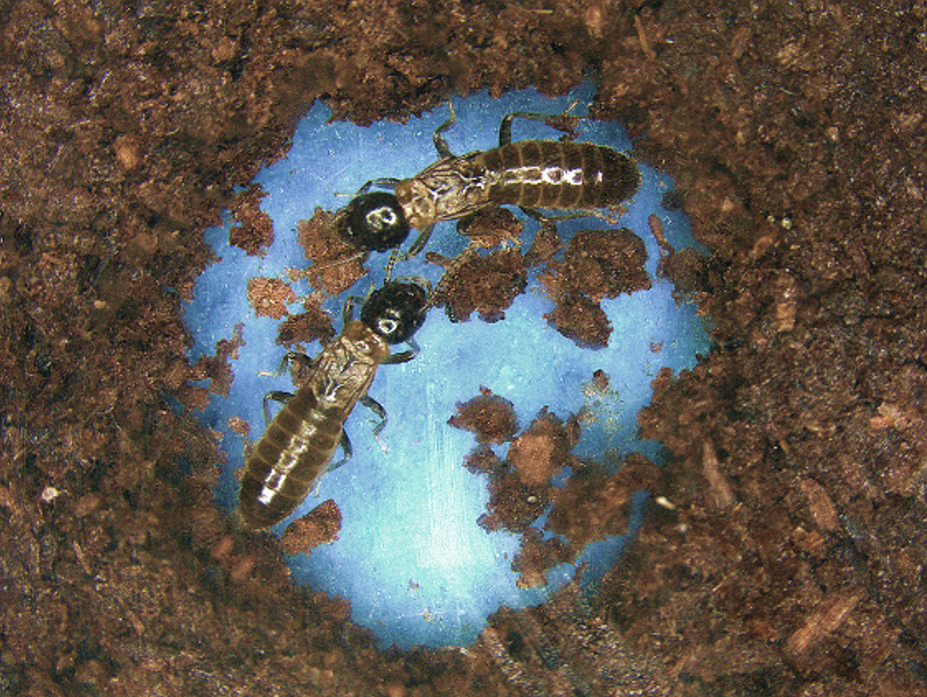Research topics - tandem runs
Here are further explanations of research topics. Good examples of what type of research we do here.
Evolution of leader role in termite tandem runs
Termites show same-sex tandem running behavior for both female-female pair and male-male pair. How they achieve such irregular pair movement coordinations? And why they can exhibit such a behavioral plasticity. Using state-of-the-art automated video tracking and trajectory analysis of movement behaviour, we revealed that same-sex tandem run is achieved by one individual behaving like the other sex. We show using data-driven simulations that this behavioral plasticity contributes to maintaining pair coordination. We also summarized all literature information about termite mating behavior of 72 species and demonstrated that they have such behavioral flexibility because the ancestor of termites did not have sex-specific leader-follower roles, where both females and males could be a leader and a follower. Termites inherited this behavioral flexibility from an ancestral lineage and use it for same-sex tandem running behavior.
Mizumoto et al., 2022 PNAS
Functional diversity of ant tandem runs
Ants also show tandem running. Different from termites, they use this behavior to recruit nestmates to new nests or food resources. Even with a similar social behavior, we found they use distinct communication systems between ants and termites, or among ant species. For example, we provided clear evidence that tandem communications of two distantly related ants, which are superficially similar and have been believed to be the same behavior, are fundamentally distinct from each other. Combining network and information theoretical analysis, we demonstrated that Temnothorax ants use tandem running behavior to recruit additional recruiters, while Diacamma ants use them to move passive colony members. Our results show that simple social interactions can conceal a great diversity across taxa, which provides a new angle to study the diversity of animal communication. Such evolutionary convergence, animals in different taxa show similar techniques for social interactions, provides an interesting opportunity to study the evolution of animal collective behavior.
Valentini et al., 2020 eLife
Mizumoto et al., 2023 iScience
Tanaka et al., 2023 STAR protocol
Communication during termite tandem runs
In collective animal behavior, coordination is often achieved by feedback between leaders and followers; however, the contribution of each role is difficult to dissect in species showing high levels of coordination. We disentangled these roles by creating heterospecific tandem pairs of mating termites, a simple case of coordination in which the female leads the male on a search for a nesting site. Our experiments reveal that different species achieve a similar level of coordination by means of different mechanisms to transfer information between sender and receiver. We further show that this species-specificity is a result of sexual selection via mate preference and competition. In short, our study highlights cryptic interspecific variation in movement coordination, a source of variation for the evolution of novel social interactions
Mizumoto et al., 2022 Proc R Soc B
We clear evidence that mating pairs of two termite species do not rely on visual information for tandem movement coordination. Instead, they use visions for determining the timing of mate pairing, which is adaptively adjusted in a species-specific manner. Thus, termites use different information channels for different purposes, tactile and chemical for coordination and visual for obtaining global information.
Mizumoto and Bourguignon, 2022 Proc R Soc B
Search strategies of mating termites
How should females and males move to search for partners whose exact location is unknown? Theory predicts that the answer depends on the searching conditions, specifically what they know about where targets can be found. We demonstrated that termites adaptively switch search modes depending on their potential distance from their partners. We found that both sexes moved actively before finding partners, which means the condition of the target locations is completely unpredictable. In stark contrast, when pairs were accidentally separated during tandem running, they showed distinct sexually dimorphic movements, where females paused for long periods while males paused only briefly and moved actively. Simulations confirmed that these movements increase the rate of successful encounters. The context-dependent switch of search modes is key to enhancing random animal encounters.
Mizumoto and Dobata 2019 Sci Adv
Furthermore, we show that males of Coptotermes gestroi, who experience a variety of mate densities, adjust their moving speed according to the surrounding density of mates to enhance encounter rates with partners.
Mizumoto et al., 2020 J Anim Ecol
Optimal movement to search for mating partners
How can males and females enhance mating encounters when they have no idea of the locations of partners? Using simulations, we found that sexually dimorphic movements can achieve the highest encounter rates under some conditions, and demonstrated that this sexual dimorphism can evolve from an initial sexually monomorphic population. Our findings connect the evolutionary ecology of sex and the biophysics of movement, providing the novel mechanisms of how sexual dimorphism can evolve.
Mizumoto et al. 2017 J R Soc Interface
Mizumoto and Dobata 2018 Sci Rep
Circadian rhythm in mate search of termites
Termites usually live within logs and underground with little light fluctuations. Thus, they rarely show circadian rhythm. However, in the mating period, termite dispersers must search for mates outside the nests at the correct time. We found that unpaired termites show daily search–rest cycles and restrict searching activity to a certain period of the day by responding to photic cycles. Termites also showed weak periodic search–rest patterns under constant darkness.
Mizumoto et al. 2017 Popul Ecol
Adaptive values of same-sex pairing by termite males
From insects to primates, various animal species show same-sex sexual behaviors such as courtship, copulation, and pairing. However, this provides the evolutionary paradox of selection because it cannot directly result in reproduction, and the occurrence of same-sex pairing is often explained by the mistaken identity of individuals. In this study, I found that termite males formed homosexual pairs like that in monogamous colony foundations and demonstrated how this contributes to their fitness. We found that pairs of male adults stopped searching for females and cooperatively established nests without females, although single males rarely ceased searching for mates. Males in such male–male partnerships had much higher survival rates than single males. Then, a male in a surviving homosexual pair invaded an incipient colony to kill the king and replace the colony. A mathematical model demonstrated that the observed strategy of establishing a male–male partnership instead of searching for females is advantageous when the risk of predation is high, even when colony fusion is rare. Pairing with another male isn’t the best option. Still, it gives mateless termites a chance to survive until they find a female, if that happens at all (Mizumoto et al. 2016 Anim Behav).







